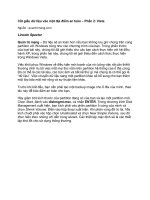Import dữ liệu vào một worksheet của một workbook excel chưa tồn tại từ tệp XML
Bạn đang xem bản rút gọn của tài liệu. Xem và tải ngay bản đầy đủ của tài liệu tại đây (181.36 KB, 15 trang )
1. Lí do chọn đề tài:
Chúng ta đang sống trong một kỷ nguyên mà mọi thành tựu khoa học và công nghệ đều
xuất hiện một cách hết sức mau lẹ và cũng được đổi mới một cách cực kì nhanh chóng.
Nghành công nghệ thông tin cũng ngày càng chứng tỏ được vị trí của mình bằng sự xuất
hiện trong rất nhiều các lĩnh vực, mọi nơi, mọi chốn của đời sống. Có thể nói, nền kinh tế
toàn cầu đang chịu ảnh hưởng sâu sắc từ công nghệ thông tin mà trong đó có không ít vai
trò của các ngành công nghệ phần mềm. Các phần mềm làm ra được ứng dụng phục vụ
cho công viêc, hoạt động của các công ty, tổ chức. Và nhiều ngôn ngữ mới cũng ra đời,
một trong đó là ngôn ngữ xml. XML (viết tắt từ tiếng Anh eXtensible Markup Language,
“Ngôn ngữ Đánh dấu Mở rộng”) là ngôn ngữ đánh dấu do W3C đề nghị. Mục đích chính
của XML là đơn giản hóa việc chia sẻ dữ liệu giữa các hệ thống khác nhau, đặc biệt là
các hệ thống được kết nối với Internet.
Đặc điểm của XML cung cấp một phương tiện dùng văn bản (text) để mô tả thông tin và
áp dụng một cấu trúc dạng cây cho thông tin đó. Tại mức căn bản, mọi thông tin đều thể
hiện dưới dạng text, chen giữa là các thẻ đánh dấu (markup) với nhiệm vụ ký hiệu sự
phân chia thông tin thành một cấu trúc có thứ bậc của các dữ liệu ký tự, các phần tử dùng
để chứa dữ liệu, và các thuộc tính của các phần tử đó. Vì vậy nhóm chúng em quyết định
chon đề tài “ Import dữ liệu vào một WorkSheet của một Workbook Excel chưa tồn tại từ
tệp XML”. Qua đây nhóm chúng em xin chân thành cảm ơn thầy Ngô Đình Thưởng đã
nhiệt tình giúp đỡ trong đề tài này.
2. Mục đích nghiên cứu
- Tìm hiểu đề tài “ Import dữ liệu vào một WorkSheet của một Workbook Excel
chưa tồn tại từ tệp XML. Tra cứu cách dùng của phưong thức CreateObject
("Excel.Application").
- Thiết kế Demo Import dữ liệu
3. Phương pháp nghiên cứu
- Phương pháp tiếp cận thu thập thông tin: trên các website.
- Phương pháp nghiên cứu tài liệu: sách, các bài nghiên cứu khoa học
- Phương pháp phi thực nghiệm.
- Phương pháp thực nghiệm.
Chương1: Tổng quan về XML
I.
Giới thiệu chung về ngôn ngữ XML
1. Giới thiệu chung
• XML là ngôn ngữ tổng quát dùng để lưu trữ dữ liệu trong các thẻ có nghĩa
• Được định nghĩa bởi tổ chức mạng toàn cầu Word wide web consotium
•
•
Là ngôn ngữ đánh dấu độc lập với phần mềm, phần cứng và nền
Cho phép các cấu trúc truyền dữ liệu giữa hệ thống không đồng nhất
2. Cấu trúc của xml: Có 2 phần
Cấu trúc logic: định nghĩa các phần tử, các thuộc tính, các kiểu dữ liệu,
vv..
Cấu trúc vật lý: chứa dữ liệu và các phần tử chứa dữ liệu như text, hình
ảnh, media, vv.. Có tên mở rộng là .xml
Ví dụ:
<?xml version="1.0" encoding="utf-8"?>
<?xml – stylesheet type = “ text/css” href =” greetingcss”?>
<document>
<greeting>
Hello
</greeting>
<message>
Well come to my page
<message>
</document>
Giải thích:
<?xml version="1.0" encoding="utf-8"?>
Thẻ khai báo chỉ thị xử lí đặt ngay ở dòng đầu tiên
Trong đó:
- <document> là phần tử gốc của dữ liệu
-
</greeting>, <message> là các phần tử định nghĩa bên trong phần tử
gốc, nó có thể chứa dữ liệu hoặc phần tử gốc.
II.
Lợi ích Khi Sử Dụng XML
- Dễ dàng xử lí và trao đổi dữ liệu
- Mô tả dữ liệu và cách dữ liệu muốn thể hiện thông qua các thẻ
- Tổ chức dữ liệu có cấu trúc và phân cấp
-
XML có thể tách rời dữ liệu,sử dụng XML dữ liệu sẽ được lưu trữ trong những
-
tập tin XML riêng biệt.
XML có thể mô tả thông tin của những đối tượng phức tạp mà CSDL quan hệ
-
không thể giải quyết được
XML dùng để chia sẻ dữ liệu với những tập tin văn bản dễ hiểu
XML có thể dùng để chuyển đổi dữ liệu giữa các hệ thống không tương thích
XML dùng để lưu trữ dữ liệu làm cho dữ liệu của chúng ta hữu ích hơn
Chương 2: NỘI DUNG NGHIÊN CỨU
1. Demo chương trình
Xây dựng một form có khuôn dạng như hình vẽ. Gồm có các đối tượng:
btnBrowser: button
lbFilePath: label
btnImport: button
dtgResult: datagirdview
btnExport: button
2. Cơ sở dữ liệu: gồm tệp sample export.xls
3. Mã nguồn
Imports System.Data.OleDb
Public Class Form1
Dim connectionstring As String
Dim dtStudentGrade As DataTable
Dim dtExcelData As DataTable
Private Sub Form1_Load(ByVal sender As System.Object, ByVal e As
System.EventArgs) Handles MyBase.Load
Dim dt As New DataTable
Dim x As String
dt.Columns.Add("col1")
Dim drow As DataRow = dt.NewRow
drow(0) = "test"
dt.Rows.Add(drow)
x = dt.Rows(0)(0)
'x = dt.Rows(0)(1)
Dim field() As String
field(0) = ""
field(1) = ""
field(2) = ""
field(3) = ""
field(4) = ""
field(5) = ""
field(6) = ""
field(7) = ""
field(8) = ""
field(9) = ""
field(10) = ""
field(11) = ""
field(12) = ""
field(13) = ""
End Sub
Private Sub btnBrowser_Click(ByVal sender As System.Object, ByVal e As
System.EventArgs) Handles btnBrowser.Click
OpenFileDialog1.FileName = ""
OpenFileDialog1.Filter = "Excel files (*.xls)|*.xls|Excel(2007) files (*.xlsx)|*.xlsx|
All files (*.*)|*.*"
OpenFileDialog1.ShowDialog()
lbFilePath.Text = OpenFileDialog1.FileName
End Sub
Function ReadExcelFile()
'Use OleDbDataAdapter to provide communication between the DataTable and the
OleDb Data Sources
Dim da As New OleDbDataAdapter
'Use DataTable as storage of data from excel
Dim dt As New DataTable
'Use OleDbCommand to execute our SQL statement
Dim cmd As New OleDbCommand
'Use OleDbConnection that will be used by OleDbCommand to connect to excel file
Dim xlsConn As OleDbConnection
Dim sPath As String = String.Empty
sPath = Me.lbFilePath.Text
'Create a new instance of connection and set the datasource value to excel's path
xlsConn = New OleDbConnection("Provider=Microsoft.ACE.OLEDB.12.0;Data
Source=" & sPath & ";Extended Properties=Excel 12.0")
'Use try catch block to handle some or all possible errors that may occur in a
'given block of code, while still running code.
Try
'Open the connection
xlsConn.Open()
'Set the command connection to opened connection
cmd.Connection = xlsConn
'Set the command type to CommandType.Text in order to use SQL statment
constructed here
'in code editor
cmd.CommandType = CommandType.Text
'Assigned the command text to query the excel as shown below
cmd.CommandText = ("select * from [Sheet1$]")
'Assign the cmd to dataadapter
da.SelectCommand = cmd
'Fill the datatable with data from excel file using DataAdapter
da.Fill(dt)
Catch
'This block Handle the exception.
MsgBox(ErrorToString)
Finally
'We need to close the connection and set to nothing. This code will still execute
even the code raised an error
xlsConn.Close()
xlsConn = Nothing
End Try
Return dt
End Function
Public Sub SaveToDB(ByVal iRowIndex As Long)
Dim conn As New OleDbConnection
Dim sConnString As String
Dim cmd As New OleDbCommand
Dim sSQL As String = String.Empty
Try
'Check if the path has a backslash in the end of string
If Microsoft.VisualBasic.Right(Application.StartupPath, 1) = "\" Then
sConnString = "Provider=Microsoft.ACE.OLEDB.12.0;Data Source=" &
Application.StartupPath & "dbexport.accdb;Persist Security Info=False;"
Else
sConnString = "Provider=Microsoft.ACE.OLEDB.12.0;Data Source=" &
Application.StartupPath & "\dbexport.accdb;Persist Security Info=False;"
End If
'create a new instance of connection
conn = New OleDbConnection(sConnString)
'open the connection to be used by command object
conn.Open()
'Set the command's connection to our opened connection
cmd.Connection = conn
'Set the command type to CommandType.Text in order to use SQL statment
constructed here
'in code editor
cmd.CommandType = CommandType.Text
'Set the comment text to insert the data to database
cmd.CommandText = "INSERT INTO students_grade ( student_no,
student_name, grade ) VALUES(@student_no, @student_name, @grade)"
'Add parameters in order to set the values in the query
cmd.Parameters.Add("@student_no", OleDbType.VarChar).Value =
dtExcelData.Rows(iRowIndex)(0)
cmd.Parameters.Add("@student_name", OleDbType.VarChar).Value =
dtExcelData.Rows(iRowIndex)(1)
'This is just a sample of how to check if the field is null.
cmd.Parameters.Add("@grade", OleDbType.Numeric).Value = IIf(Not
IsDBNull(dtExcelData.Rows(iRowIndex)(2)), dtExcelData.Rows(iRowIndex)(2),
Nothing)
cmd.ExecuteNonQuery()
Catch ex As Exception
MsgBox(ErrorToString)
Finally
conn.Close()
End Try
End Sub
Public Sub Load_Data()
Dim conn As New OleDbConnection
Dim sConnString As String
Dim cmd As New OleDbCommand
Dim da As New OleDbDataAdapter
Try
'create a new instance of dtStudentGrade, this datatable will be used to export
'data from database to excel
dtStudentGrade = New DataTable
'Check if the path has a backslash in the end of string
If Microsoft.VisualBasic.Right(Application.StartupPath, 1) = "\" Then
sConnString = "Provider=Microsoft.ACE.OLEDB.12.0;Data Source=" &
Application.StartupPath & "dbexport.accdb;Persist Security Info=False;"
Else
sConnString = "Provider=Microsoft.ACE.OLEDB.12.0;Data Source=" &
Application.StartupPath & "\dbexport.accdb;Persist Security Info=False;"
End If
'create a new instance of connection
conn = New OleDbConnection(sConnString)
'open the connection to be used by command object
conn.Open()
'Set the command's connection to our opened connection
cmd.Connection = conn
'Set the command type to CommandType.Text in order to use SQL statment
constructed here
'in code editor
cmd.CommandType = CommandType.Text
'Set the comment text to load the data from database
cmd.CommandText = "select * from students_grade"
'assign the cmd object to dataadapter selectcommand property in order to use it to
fill the dtStudentGrade
da.SelectCommand = cmd
'Populate the dtStudentGrade with the data from database
da.Fill(dtStudentGrade)
'Set the datagridview datasource to dtStudentGrade in order to dispaly the data to
user
dtgResult.DataSource = dtStudentGrade
Catch ex As Exception
MsgBox(ErrorToString)
Finally
conn.Close()
End Try
End Sub
Public Sub ImportToDB()
'Create a new instance of dtExcelData datatable
dtExcelData = New DataTable
'Set the cursor to wait cursor
Windows.Forms.Cursor.Current = Cursors.WaitCursor
'Call ReadExcelFile function to get the data from excel
dtExcelData = ReadExcelFile()
'Reset the progressbar
Me.ProgressBar1.Value = 0
'Get the DataTable row count to set the progressbar maximum value
Me.ProgressBar1.Maximum = dtExcelData.Rows.Count
Me.ProgressBar1.Visible = True
'Use looping to read the value of field in each row in DataTable
For i = 0 To dtExcelData.Rows.Count - 1
'Check if the student number has a value
If Not IsDBNull(dtExcelData.Rows(i)(0)) Then
'call save procedure and pass the row varialble i(row index) as parameter to
save each the value of each field
SaveToDB(i)
'Increase the value of progressbar to inform the user.
Me.ProgressBar1.Value = Me.ProgressBar1.Value + 1
End If
Next
dtExcelData = Nothing
'Call the Load_Data procedure that will load the data and display it to DataGrid
Load_Data()
'Inform the user that the importing of data has been finished
MsgBox("Data has successfully imported.", MsgBoxStyle.OkOnly, "Import Export
Demo")
End Sub
Private Sub btnImport_Click(ByVal sender As System.Object, ByVal e As
System.EventArgs) Handles btnImport.Click
'Check if there's a selected excel file to be imported
If Len(Trim(Me.lbFilePath.Text)) > 0 Then
ImportToDB()
Else
'Inform the user if no selected excel file.
MsgBox("Please select a file.", MsgBoxStyle.OkOnly, "Import Export Demo")
End If
End Sub
Private Sub releaseObject(ByVal obj As Object)
Try
'Call the release object function to release the object before disposing
System.Runtime.InteropServices.Marshal.ReleaseComObject(obj)
obj = Nothing
Catch ex As Exception
obj = Nothing
Finally
'Call the Garbage collector to free the resources consumed by created instances
GC.Collect()
End Try
End Sub
Private Sub ExportExcel()
'Create excel objects
Dim xlApp As Microsoft.Office.Interop.Excel.Application
Dim xlBook As Microsoft.Office.Interop.Excel.Workbook
Dim xlSheet As Microsoft.Office.Interop.Excel.Worksheet
Dim oValue As Object = System.Reflection.Missing.Value
Dim sPath As String = String.Empty
'cereate new object SaveFileDialog that will be use to save the file
Dim dlgSave As New SaveFileDialog
'Create a new instance of databale, this will server as container of data
Dim dt As New DataTable
'We need to set the default extension to xls so the SaveFileDialog will save the file
'as excel file
dlgSave.DefaultExt = "xls"
'Set the filter for SaveFileDialog
dlgSave.Filter = "Microsoft Excel|*.xls"
'set the initial path, you may set a different path if you like
dlgSave.InitialDirectory = Application.StartupPath
'Export the data if the user click the ok button of SaveFileDialog
If dlgSave.ShowDialog = Windows.Forms.DialogResult.OK Then
Try
'Create a new instance of excel application
xlApp = New Microsoft.Office.Interop.Excel.Application
'Create an excel workbook
xlBook = xlApp.Workbooks.Add(oValue)
'Create an excel sheet named sheet1
xlSheet = xlBook.Worksheets("sheet1")
Dim xlRow As Long = 2
Dim xlCol As Short = 1
'To create a column for excel we need to loop through
DataTable(dtStudentGrade)
For Each col As DataColumn In dtStudentGrade.Columns
'Get the column name and assigned it to excel sheet cells
'to assign value to each cell we need to specify the row and column
xlSheet.Cells(row, column)
xlSheet.Cells(1, xlCol) = col.ColumnName
'Increment the xlCol so we can set another column
xlCol += 1
Next
'reset the progressbar
Me.ProgressBar1.Visible = True
Me.ProgressBar1.Minimum = 0
Me.ProgressBar1.Maximum = dtStudentGrade.Rows.Count
'Loop through dtStudentGrade to get the value of each field in a row
For Each row As DataRow In dtStudentGrade.Rows
'Reset xlCol's value to 1
xlCol = 1
'Loop through dtStudentGrade and set the value of each excel sheet cells
For Each col As DataColumn In dtStudentGrade.Columns
'Assign the value of each field to selected excel sheet cell
xlSheet.Cells(xlRow, xlCol) = row(xlCol - 1)
'Increment the xlCol so we can set another the the value of another cell
xlCol += 1
Next
'Increment the xlCol
xlRow += 1
'Set the value of progressbar
If Me.ProgressBar1.Maximum > Me.ProgressBar1.Value + 1 Then
Me.ProgressBar1.Value = Me.ProgressBar1.Value + 1
End If
Next
'Set the filename and set the filename to xlx to save the file as excel 2003
'You may remove the Replace function and save the file with xlsx(excel 2007)
extension
Dim sFileName As String = Replace(dlgSave.FileName, ".xlsx", "xlx")
'save the file
xlSheet.SaveAs(sFileName)
'close the workbook
xlBook.Close()
'Quit the application using this code
xlApp.Quit()
'Release the objects used by excell application by calling our procedure
releaseObject
releaseObject(xlApp)
releaseObject(xlBook)
releaseObject(xlSheet)
'Reset the progressbar
Me.ProgressBar1.Value = 0
Me.ProgressBar1.Visible = False
'inform the user if successfull
MsgBox("Data successfully exported.", MsgBoxStyle.Information,
"PRMS/SOB Date Tagging")
Catch
MsgBox(ErrorToString)
Finally
End Try
End If
End Sub
Private Sub btnExport_Click(ByVal sender As System.Object, ByVal e As
System.EventArgs) Handles btnExport.Click
ExportExcel()
End Sub
End Class
KẾT LUẬN
1. Kết quả đạt được :
-
Thông qua đề tài “ Import dữ liệu vào một WorkSheet của một Workbook Excel
chưa tồn tại từ tệp xml” tất cả các thành viên trong nhóm đã hiểu rõ được cách
nghiên cứu một bài báo khoa học từ đó rút kinh nghiệm bản thân để làm các đề
tài, khóa luận, bài tập lớn để phục vụ cho việc học tập và làm việc sau này.
- Hơn nữa, đề tài còn giúp chúng em hiểu rõ hơn về ngôn ngữ Xml và ứng
dụng của xml, biết cách import dữ liệu vào một WorkSheet của một Workbook
Excel chưa tồn tại từ tệp xml
2. Một số hạn chế
- Chương trình code dài, khó hiểu
- Sử dụng System.Data.OleDB khó hiểu hơn so với sử dụng
Reference và Imports Microsoft.Office.Interop.Excel trong Project
3. Hướng phát triển của đề tài
-
TÀI LIỆU THAM KHẢO
[1]. Tài liệu về xml.
[2]. Tham khảo trên các trang website.
[3]. Giáo trình phương pháp nghiên cứu khoa học Nguyễn Tấn Lê.









